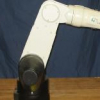Free Online Productivity Tools
i2Speak
i2Symbol
i2OCR
iTex2Img
iWeb2Print
iWeb2Shot
i2Type
iPdf2Split
iPdf2Merge
i2Bopomofo
i2Arabic
i2Style
i2Image
i2PDF
iLatex2Rtf
Sci2ools
88
Voted
ICPR
2006
IEEE
2006
IEEE
Direct Mapping of Visual Input to Motor Torques
Most methods for visual control of robots formulate the robot command in joint or Cartesian space. To move the robot these commands are remapped to motor torques usually requiring a dynamic model of the robot. In this paper we present a method for parameterizing joint torques and learning to map visual input directly to them. The system is implemented and used to control a CRS 465 robot. The results of the implementation demonstrate that the parameterization of the torques allows both the motion and position of the robot's end effectors to be controlled. Moreover, it is shown that it is possible to map visual input directly to joint torques.
Related Content
| Added | 09 Nov 2009 |
| Updated | 09 Nov 2009 |
| Type | Conference |
| Year | 2006 |
| Where | ICPR |
| Authors | Jeremiah J. Neubert, Nicola J. Ferrier |
Comments (0)

